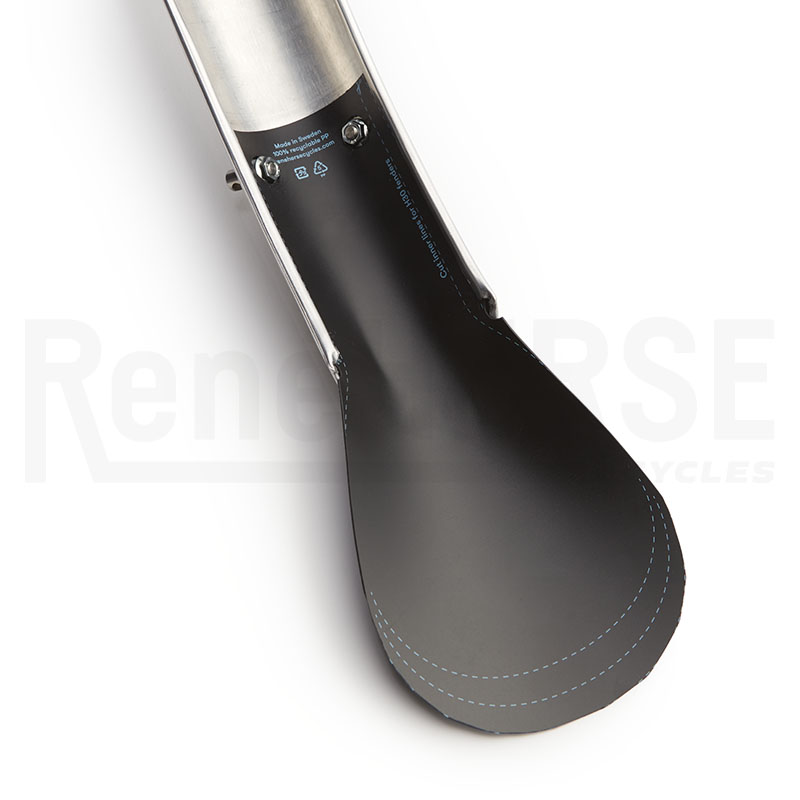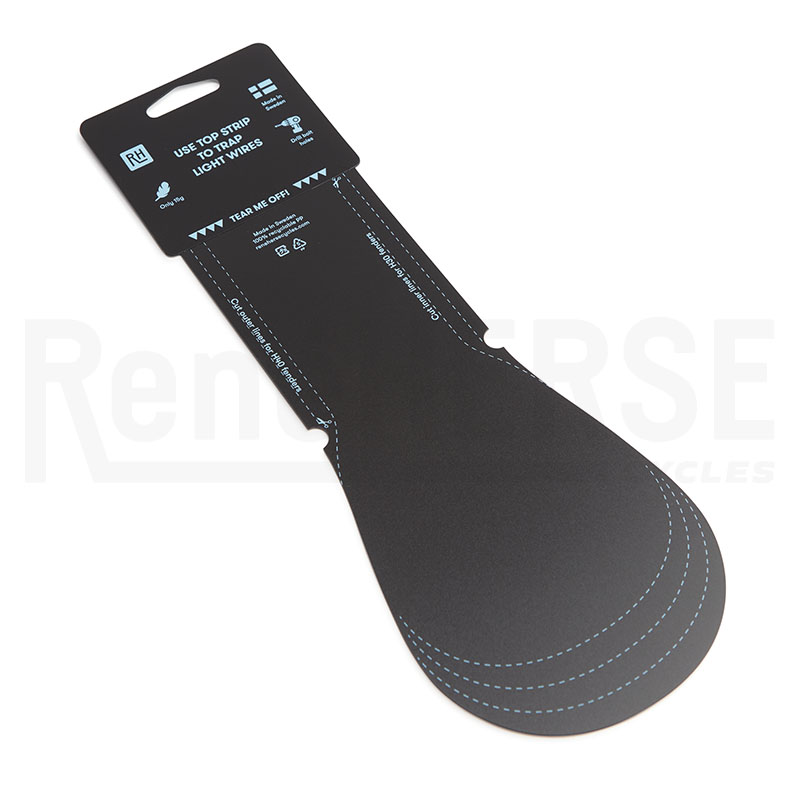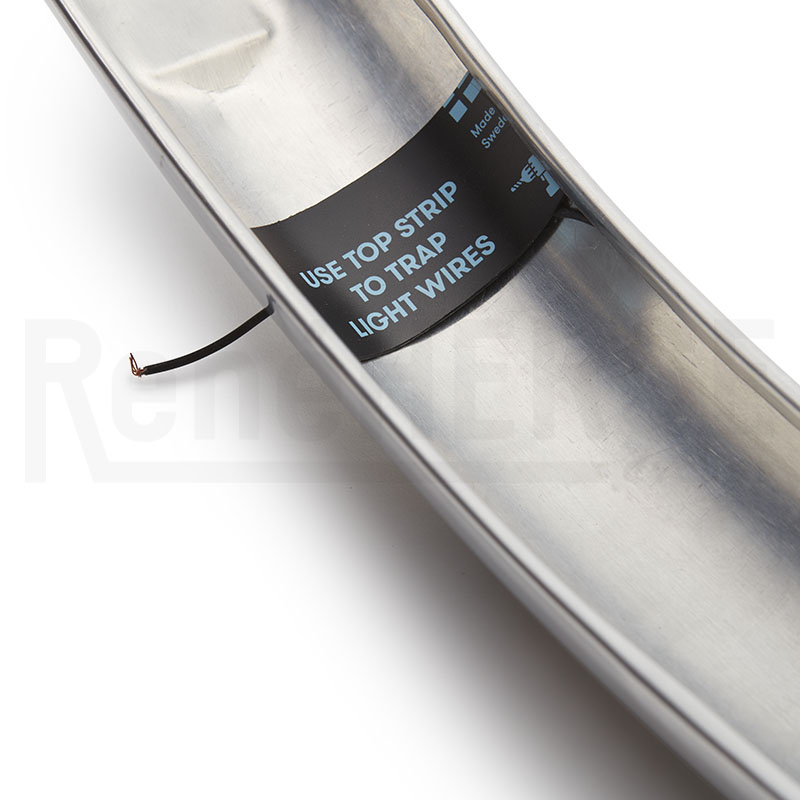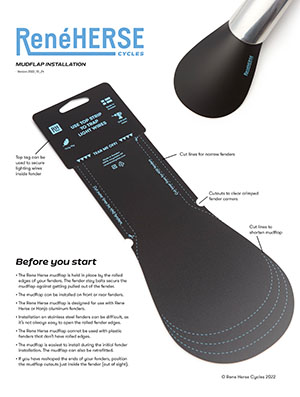Rene Herse Mudflaps
Mudflaps are humble, yet important, parts of our bikes. With fenders, the water exits at the bottom of the fender. On the front fender, that water then gets incorporated into the spray from the front wheel. As a result, a fender without a mudflap actually can spray more water onto your feet (and your bike’s drivetrain) than a bike without any fenders at all!
The search for the perfect mudflap has been going on for a long time. The very first mudflaps, more than a century ago, were made from leather, but this material really doesn’t like getting wet. In the rain, leather mudflaps become very flexible. When you ride fast, the flap bends backward and becomes next to useless. By the 1950s, most mudflaps were made from rubber, which retains its properties in the wet. Ernest Csuka of Cycles Alex Singer showed me how to cut mudflaps from sheets of rubber. He secured them by sliding them into the rolled edges of the fenders, then crimping the edges. This gives the mudflap a curved shape, making it stiffer so it will stay in place even at very high speeds.

Rubber mudflaps have one disadvantage: They are relatively heavy. So when Peter Weigle built his superlight bike for the Concours de Machines (above), I wanted to add a mudflap, as the forecast predicted rain for the long rides that tested the reliability of the bikes. Looking for a suitable material, I found a file folder made from black plastic. I cut a superlight mudflap from the material, and it worked great during the Concours. It wasn’t a long-term solution, though: The brittle plastic soon cracked and became useless.

Searching for better material, I turned to our friends at Ass Savers. They are experts on making mudflaps and even entire fenders from flexible plastic. Over the last two years, we’ve brainstormed ideas, tested various solutions, fine-tuned the design, tested more, made expensive tooling… Now we are proud to introduce the Rene Herse mudflaps.

We’ve refined the shape over many iterations until we feel it’s ‘just right.’ At 15 g, the mudflaps are superlight. In our testing, they’ve lasted through thousands of rainy miles. We’ve even scraped them over curbs dozens of times. Mudflaps are consumables, but these will last a very long time.

The mudflap slides into the rolled edges of aluminum fenders. (Use the Rene Herse Fender Edge Tool to open the fender edge so the mudflap can slide in.) Small cutouts clear the crimped corners of the fender. The mudflap extends beyond the fender stay bolts, which hold the mudflap in place. Installation is easy: Remove the stay bolts, insert the mudflap, drill the holes through the mudflap, reinstall the fender bolts.

The mudflap is sized for Rene Herse H-80 fenders (for 38-44 mm tires). Cut lines at the top show how to resize the flap for narrower fenders. At the bottom, there are cutlines to shorten the mudflap for front fenders: The bottom edge should be 3-4 cm (1.5″) from the ground. Any lower, and it scoops water into your fender!

You can also make the mudflap removable without tools: Simply drill out the holes for the stay bolts to 12 mm, so they fit over the nuts that hold the stay bolts. The nuts still hold the flap in place—to remove it, you push up the center of the mudflap, starting at the end of the fender, and pull the flap out of the fender edges. The removable installation is what I used for the Concours de Machines, so I could take off the flap for the really rocky mountain bike trails that were part of the course.

The flexible plastic is also perfect for holding lighting wires in place inside the fender. If you run your wires through the rolled edges of the fender, you need to route it to the center and up toward the fork crown. The hang tag of the mudflap is designed for that purpose. That’s why it’s wider than the mudflap itself—the wire guide is shorter than the mudflap and doesn’t curve as much with the fender, so it needs to be a little wider.
As with all our components, illustrated step-by-step instructions show how to install the mudflaps.
The mudflaps are made in Sweden from recycled plastic. They can be recycled again once they wear out. (They are made from No. 5 plastic, which really can be recycled unlike many other plastics.) It’ll be a long time until that happens: Ass Savers’ material is tough, and the mudflaps will last a long time. We’ve got the mudflaps in stock now.
More information:




